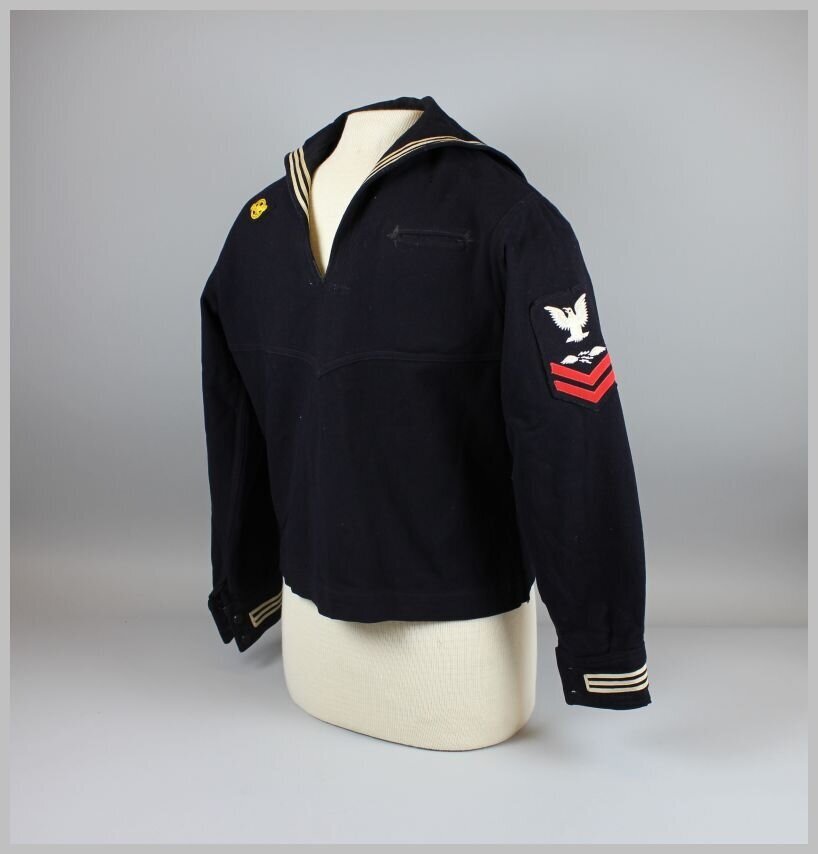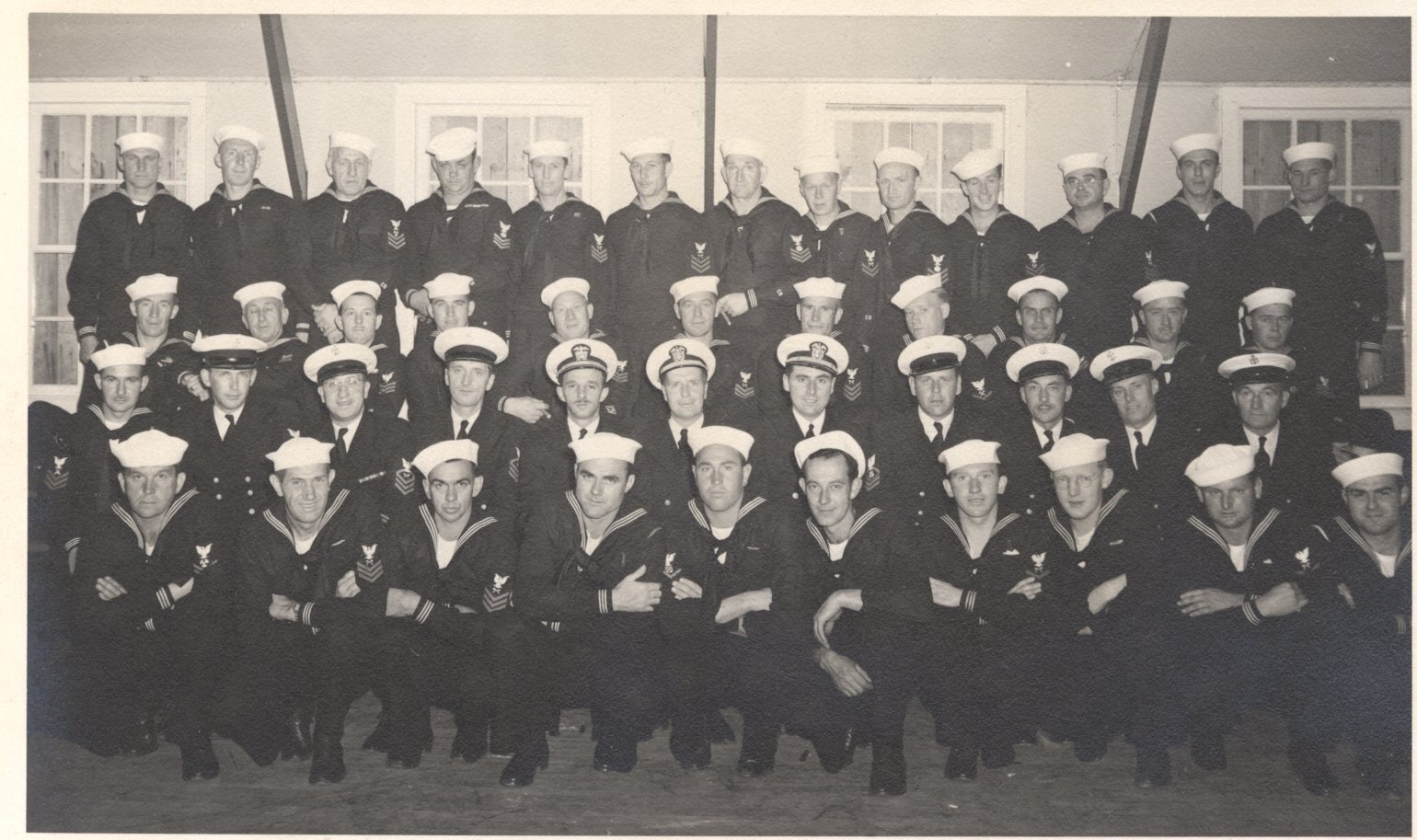History of the US Coast Guard
Tags: historic photo, History Collection, OceansIt’s #WayBackWednesday and we are diving deep into OCEANS this week in celebration of #WorldOceanDay2020. Today we actually have a little bit of a collection history mystery! We have this wonderful uniform that belonged to Abilene-native Hal Pender. The Pender family is a long-standing prominent family to Abilene so we have information on Mr. Pender as found in his obituary and from family narrative history. Take a look at this excerpt from the obituary:
Born in Abilene, Texas on November 16, 1922, Hal was the son of Mary Paxton and Herman Arthur Pender. He was a graduate of Abilene High School and received a Bachelor of Business Administration degree from Hardin-Simmons University. Hal served in the U S Navy (1943-1946) attaining the rank of Aviation Tech 2nd Class.
Now for the mystery! Take a look at this uniform jacket. What you cannot see is the tag inside the uniform lists it as a Coast Guard uniform. Look below at the comparison images that show Coast Guard and Navy uniforms from around the 1940s. Can you help us solve this mystery?
United States Navy Uniform Shirt, Belonged to Hal Pender, c. 1943-1946. Collection of the Grace Museum, Gift of Mrs. Martha Pender
COAST GUARD
COAST GUARD, Crew members of the Corson Inlet Coast Guard Station 1952 & 1953, Strathmere, New Jersey
VS.
NAVY
US NAVY, 79th Battalion – Seabee’s, Kodiak, Alaska
BRIEF TIMELINE OF THE US COAST GUARD (1700s-1950)
1716 First Lighthouse build in America at Little Brewster Island, Boston, MA
1789 7 August. An Act of Congress, the first to make any provisions for public works, created the Lighthouse Establishment, when it accepted title to, and joined jurisdiction over, the 12 lighthouses then in existence, and provided that “the necessary support, maintenance and repairs of all lighthouses, beacons, buoys and public piers erected, placed, or sunk before the passing of this act, at the entrance of, or within any bay, inlet, harbor, or port of the United States, for rendering the navigation thereof easy and safe, shall be defrayed out of the treasury of the United States.” Prior to this time the lighthouses had been paid for, built and administered first by the colonies and then the states.
1790 4 August. Congress authorized Secretary of the Treasury Alexander Hamilton’s proposal to build ten cutters to protect the new nation’s revenue. Alternately known as the system of cutters, Revenue Service, and Revenue-Marine this service would officially be named the Revenue Cutter Service in 1863. The cutters were placed under the control of the Treasury Department. This date marks the officially recognized birthday of the Coast Guard.
1852 30 August. Congress passed the Steamboat Act establishing the Steamboat Inspection Service under the control of the Treasury Department. The Act provided for the appointment of nine supervising inspectors, experts in the construction and operation of commercial craft. It authorized local inspectors, acting under the supervising inspectors, to issue licenses to engineers and pilots of passenger vessels.
1877 Training of first class of Revenue Cutter cadets began on the school-ship Dobbin, with nine cadets, three officers, one surgeon, six warrant officers and 17 crewmen on board.
A crew of Native Americans from the local Makah Reservation manned the Neah Bay, Washington, Life-saving Station with a white station keeper. They are among the first known Native Americans in the service.
1900 8 September. A hurricane strikes Galveston, Texas. (Later estimated as a Category 4 on the Saffir-Simpson scale) It is considered to be the deadliest hurricane in American history with death toll estimated between 6,000 and 12,000. RCS and LSS personnel search for survivors and offer humanitarian aid.
1905 10 December. Light Vessel No. 58 was the first U.S. vessel of any type to transmit a distress call by radio when, during a heavy gale, while relieving Nantucket LV 66, a serious leak developed in fire-room compartment; suction pumps clogged repeatedly; distress messages sent by radio were handled by Newport Naval Station in Rhode Island. Rising water eventually extinguished the boiler furnaces and the ship was then bailed by hand for 24 hours. Tender Azalea responded, arriving at 0400 on 11 December and started towing about 1100. Heavy cross-seas hindered the operation and about 4 hours later, the lightship signaled “must abandon”. Her crew was safely taken aboard Azalea and 10 minutes later LV 58, listing heavily to starboard, went down by the stern in 25 fathoms of water about 18 miles northwest of the station.
1912 4 April. President Taft recommended abolishing Revenue Cutter Service to cut expenses. His actions led to the eventual creation of the Coast Guard three years later by merging the Revenue Cutter Service and the Life-Saving Service on 28 January 1915.
1912 14 April. RMS Titanic collided with an iceberg off Newfoundland while sailing on her maiden voyage from Southampton to New York. She sank a little over two hours later. There were 1,517 lost including 103 women and 53 children out of total passenger and crew of 2,207. The tragedy led to the creation of the International Ice Patrol.
1914 24 June. Congress authorized the Secretary of Treasury to “detail for duty on revenue cutters such surgeons and other persons of the Public Health Service as…necessary” and for cutters with medical personnel on board to extend medical aid to crews of American vessels. This Act regularized assignment of Public Health Service personnel to revenue cutters, launching a partnership between the two services that survives to this day.
1915 28 January. President Woodrow Wilson signs the bill merging the Life-Saving Service and the Revenue Cutter Service to establish the U.S. Coast Guard.
1916 Third Lieutenants Elmer Stone and Norman Hall, serving on Onondaga, fly the first Coast Guard air reconnaissance with a plane borrowed from the Navy.
President Woodrow Wilson creates the Interdepartmental Board on International Service of Ice Observation, Ice Patrol, and Ocean Derelict Destruction. The Board was directed to prepare a systematic program of scientific observations to be carried out by the cutters serving on the International Ice Patrol, inaugurating the practice of oceanography with the Coast Guard.
1 April. The first Coast Guardsmen, Elmer Stone and Charles E. Sugden, reported for flight training at the naval air station in Pensacola, Florida.
1920 16 January. The Volstead Act, better known as Prohibition, goes into effect. Enforcement of the Act fell to the Treasury Department; the “Rum War” dominates Coast Guard’s missions until the Act is repealed in 1933.
1939 1 July. U.S. Lighthouse Service is consolidated with the Coast Guard. Made in the interest of efficiency and economy, the plan integrated approximately 30,000 aids to navigation (including light vessels and lighthouses), 5,200 employees, 64 buoy tenders, 30 depots, and 17 district offices.
1942 March. The first 150 African American volunteers who enlisted after the Coast Guard opened all rates began training at the Coast Guard’s integrated training facility at Manhattan Beach, New York City.
1945 September. The Japanese sign the articles of surrender aboard the USS Missouri in Tokyo Bay, ending the war.
The Coast Guard Cutter USCG 83525 was the first and only cutter to host an official surrender ceremony when Imperial Japanese Army Second Lieutenant Kinichi Yamada surrendered the garrison of Aguijan Island on board this vessel. Rear Admiral Marshall R. Greer, USN, accepted their surrender for the United States.
1948 July. President Harry Truman orders the integration of the armed forces of the United States. By this time the Coast Guard had already opened all rates to all qualified persons regardless of race. The Coast Guard noted “the importance of selecting men for what they are, for what they are capable of doing, and insisting on good conduct, good behavior, and good qualities of leadership for all hands. . .As a matter of policy Negro recruits receive the same consideration as all others.” Evergreen is the first Coast Guard cutter strictly dedicated to oceanographic study.


